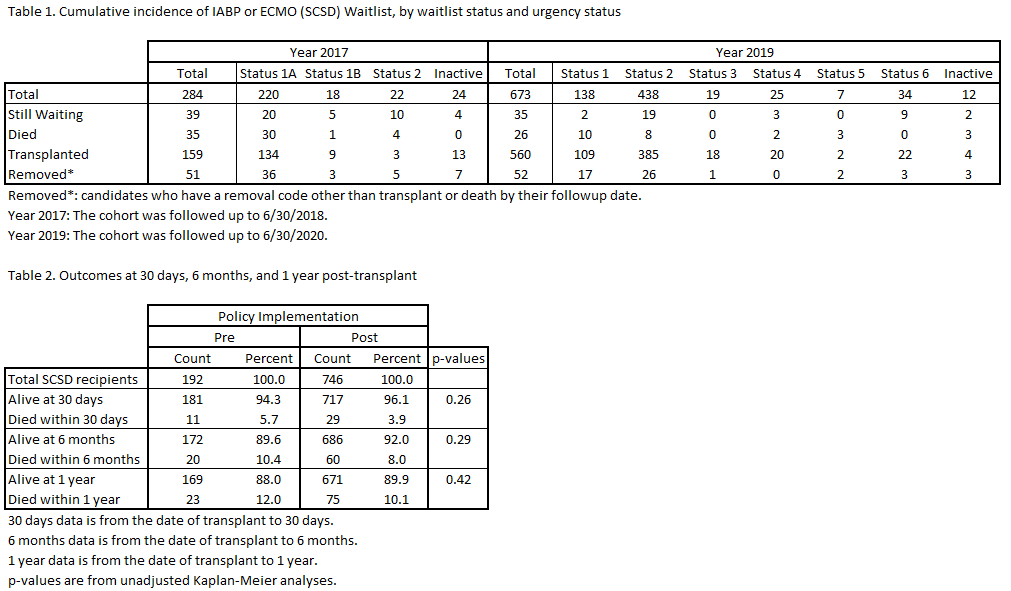Waitlist and Post-Transplant Outcomes of Candidates with Iabp or Ecmo: Comparison of Old and New Heart Allocation Policies
1Univ of Michigan, Ann Arbor, MI, 2SRTR, Minneapolis, MN, 3Baylor Univ, Dallas, TX, 4St. Vincent Heart Ctr, Indianapolis, IN
Meeting: 2021 American Transplant Congress
Abstract number: 50
Keywords: Allocation, Heart assist devices, Public policy, Waiting lists
Topic: Clinical Science » Heart » Heart and VADs: All Topics
Session Information
Session Name: Heart: Triple "D" in Heart Transplantation: DCD, Dual-Organ and Declined Hearts
Session Type: Rapid Fire Oral Abstract
Date: Saturday, June 5, 2021
Session Time: 4:30pm-5:30pm
 Presentation Time: 5:05pm-5:10pm
Presentation Time: 5:05pm-5:10pm
Location: Virtual
*Purpose: New heart allocation policy prioritizes candidates on short-term circulatory support to promote transplant of the sickest candidates. There has been a shift in the use of these devices as a bridge to transplant. We compared the use and outcomes of candidates with IABP or ECMO before and after the new policy.
*Methods: Using SRTR data, we estimated unadjusted cumulative incidence (CI) of waitlist (WL) outcomes and post-transplant (PT) survival for adult heart candidates and recipients. The WL cohort included IABP or ECMO (SCSD) candidates 18+ years first listed in 2017 and 2019, respectively. WL follow-up was censored at death, transplant, WL removal, or the first June after the listing year. We fit a CI function to compare WL outcomes. The PT cohort included recipients with SCSD 18+ years who underwent transplant from 10/18/2017 to 7/31/2018 (PRE) and 10/18/2018 to 7/31/2019 (POST). PT follow-up was censored on death or 1 year after transplant. We fit unadjusted Kaplan-Meier survival curves for 30-day, 6-month, and 1-year survival.
*Results: After implementation of the new allocation policy, the number of WL candidates with SCSD increased 137%, from 284 to 673. In 2019, 83% of SCSD WL candidates underwent transplant, versus 56% in 2017. In 2017, most SCSD candidates were listed as status 1A, and 61% received transplants. In 2019, most SCSD candidates were listed as status 1 or 2; 79% and 88% of them, respectively, received transplants (Table 1). The PT cohort included 192 and 746 recipients PRE and POST, respectively, a 289% increase. PT survival among PRE was 94.3% at 30 days, 89.6% at 6 months, and 88% at 1 year. PT survival POST was 96.1% at 30 days, 92% at 6 months, and 89.9% at 1 year.
*Conclusions: Since implementation of the new policy, the number of recipients with SCSD and their survival, have increased slightly. Although the increase is not statistically significant, new strategies for advanced heart failure management may be needed given the increasing use and improved outcomes of short-term devices.
To cite this abstract in AMA style:
Colvin M, Ahn Y, Hall S, Skeans M, Walsh M, Israni A. Waitlist and Post-Transplant Outcomes of Candidates with Iabp or Ecmo: Comparison of Old and New Heart Allocation Policies [abstract]. Am J Transplant. 2021; 21 (suppl 3). https://atcmeetingabstracts.com/abstract/waitlist-and-post-transplant-outcomes-of-candidates-with-iabp-or-ecmo-comparison-of-old-and-new-heart-allocation-policies/. Accessed December 18, 2025.« Back to 2021 American Transplant Congress

